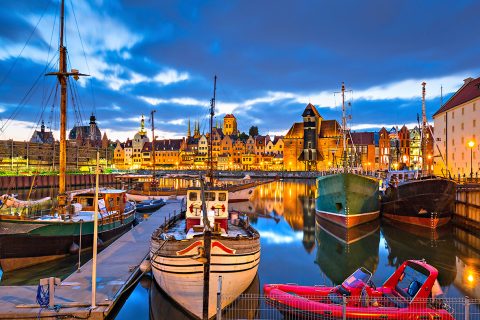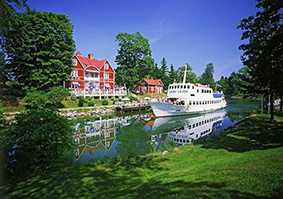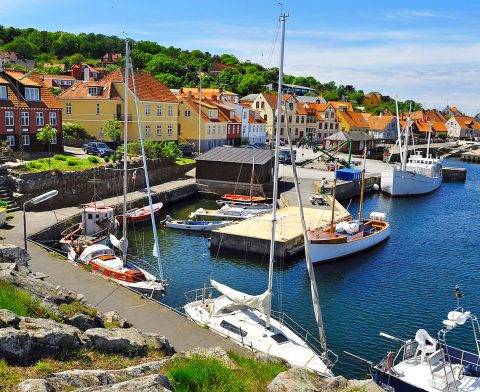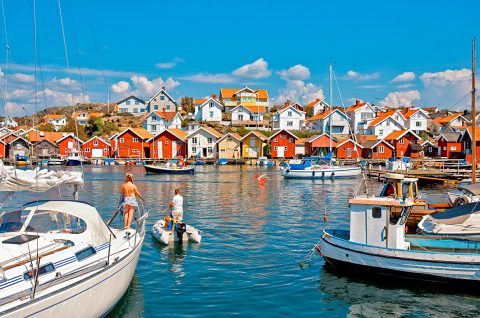Southern and middle Baltic Sea
Grand voyage from Gothenburg to Gdańsk
What a diversity! Skerries, cliffed coasts, canals across Sweden and inland lakes with green shores. Plus picturesque limestone islands out at sea, spits of land and lagoons off the Polish coast.
The Southern Baltic Sea is a diverse and multifaceted cruising ground: there are the shores of the peninsula of Scania opposite Zealand in Denmark or Småland and Blekinge near Karlskrona on the eastern coast. And there are lonesome and quiet limestone islands with chalk cliffs such as Öland or Gotland, which is even farther out at sea. Other attractions are the skerries fronting the capital of Stockholm and, last but not least, the Göta canal and lakes Vänern and Vättern where you have a chance to explore the kingdom on your own vessel and get in touch with the locals. Bornholm, which is famous for granite, is also a really worthwhile trip.
Skerries, lagoons and cliffs
Poland’s shallow coastline is in stark contrast to the Swedish one: there are only a few groynes and stone structures that protect the coast but lots of sandy beaches, lagoons and shifting dunes – similar to the ones in the Sahara Desert – such as in Łeba in Slowinski National Park. In the Szczecin and Vistula lagoons, the water is calm. With the old Hanseatic town and the Crane Gate, the bay of Gdańsk, however, makes for a nice change. Off the Polish coast, you can still find quiet and even lonesome beaches away from the major seaside resorts.
This potpourri of cultures, coastlines and waters in the Baltic Sea is waiting to be explored – and affords numerous marinas and harbours. While some of them are far off, others are real highlights amidst the cities of Gothenburg, Gdańsk and Stockholm, the Swedish capital.
Poland and Bornholm
With some 500km of Baltic Sea coastline, the country between east and west provides cruising grounds that are dominated by sand dunes and spits of land. Out at sea, Bornholm in Denmark is worth a trip.
Because of the many yacht clubs and marinas such as in Świnoujście, Kołobrzeg, Ustka, Łeba, Gdynia and Gdańsk, Poland’s 500km of Baltic Sea coastline has seen a boom in water sports. There is a marina even at the famous wooden pier in Sopot.
Going from the mouth of the river Świna to Kaliningrad, you have four cruising grounds: the straight, shallow Baltic Sea coast, the Szczecin lagoon, the bay of Gdańsk that opens up behind the peninsula of Hel and the Vistula lagoon that is separated from the Baltic Sea by the spit of land on which Krynica Morska marina is located.
To access the Polish part of the lagoon, go up the river Vistula, pass the Gdańska Głowa lock and continue on the river Szkarpawa. If you want to take the Strait of Baltiysk for direct access from the Baltic Sea, you need a Russian visa.
Going around the Danish island of Bornholm is an attractive cruise. Three marinas are available for berthing: the small harbour of Vang in the north, Rønne in the west and Nexø in the east.
Sweden by boat
With 8,000km of coastline, over 1,000 canals and 96,000 lakes, the kingdom of Sweden is a superb cruising ground for both national and foreign skippers.
One in six Swedish citizens owns a boat. Looking at the length of coastline and sheer number of lakes, this comes as no surprise. No matter how small, almost any coastal village or town provides berthing and infrastructure (boat slips, sanitary facilities). Although the number of berths is high, space can get scarce at the major destinations in the summer so that guest boats may need to raft up.
The Swedish coastline is characterised by skerries, groups of (off-lying) islands and islets. Some skerries are tiny, smooth and barren cliffs eroded by the water, some are big, forested and often populated islands. The biggest and most beautiful skerries are located outside Stockholm and Gothenburg, near Örnsköldsvik and Lulea in Northern Sweden, outside Karlskrona and Västervik on the south-eastern coast as well as near St. Anna in the province of Östergötland. Pleasure craft entering the skerries from the sea should stick to the marked fairways. In the skerries or when approaching the harbours in the skerries from the sea, bear in mind that surveying off mapped fairways may be poor and that there may be unmapped cliffs or shallows.
Sweden’s biggest lakes are Vänern at 5,585m², Vättern at 1,899m², Mälaren at 1,140m² and Hjälmaren at 493m². There are no restrictions for motorboats on lakes. They can be used wherever pleasure boats are allowed. Speed limits are indicated.
In addition to the lakes, there are beautiful canals and other waterways where you can enjoy the endless pleasures of boating.
Öland, lying just off the eastern coast and famous for its stone monuments, is a must-see. On this island, the Swedish royal family has their summer residence, Sollidens Slott.
Boaters who do not mind a longer cruise, can go to Gotland, a limestone island with small fishing villages, or Fårö island whose eastern tip is a nature reserve.
Across Sweden at a low pace
From Gothenburg to Stockholm – from west to east on the magnificent Trollhätte and Göta canals and the Vänern and Vättern lakes.
Sweden’s dense canal system which includes the Trollhätte and Göta canals is perfect for a boating holiday. Traffic is quieter than on other European waterways. The Trollhätte, Södertälje and Göta canals as well as the Vänern and Vättern lakes connect Gothenburg and Stockholm. This is a very attractive way to explore Sweden’s inland, going west to east.
At Gothenburg, head north up the Trollhätte canal into lake Vänern. It would take you about 9 hours to cover the 43nm (80km) and negotiate the 6 locks. Allow at least 3 to 4 days for the Trollhätte canal and lake Vänern because of wait times and onshore visits. On the shores of the large Vänern and Vättern inland lakes, there are several marinas to berth your boat and roam the countryside.
On the eastern shore of Vänern, the Göta canal flows into the lake near Sjötörp. Built between 1810 and 1832 and being a valuable contribution to culture and history, the canal was THE Swedish building of the millennium. 58,000 Swedish soldiers dug out an 87km section by hand. It is 190km long and has 58 locks; the famous staircase lock at Berg being one of them.
On this cruise, boaters get up close to the people, landscape and wildlife. You will pass small towns, vast plains and primeval forests at 5kn, provided you take your time.
During the peak season, the cruise from Sjötörp to Mem on the Baltic Sea takes 6 to 7 days. Factor in some extra days if you want to do some onshore sightseeing. At 91.8m above sea level, lake Viken is the highest spot of the cruise.
Plan for delays at bridges and locks (call channel 9) in the canal. At the staircase locks of Hajstorp-Riksberg, Carl Johan in Berg and Borenshult in Motala, delays may be up to 2 hours. Commercial vessels and trains have priority.
Lifejackets, fenders, 8-10m stern lines and 12m headlines are mandatory in locks.
Opening hours and tickets
Locks and bridges are permanently staffed in the peak season from mid-June to mid-August. Between May and mid-June and between mid-August and late September, give the staff a call 4 working days before your arrival. Affix the canal ticket to your boat in a manner that it is clearly visible. It is valid for the skipper and boat and is non-transferable. Another skipper may make the return journey, though. Holders of a season return ticket (parts of or entire Göta canal) can make any number of journeys on the canal.
The Göta canal ticket (not the lock tickets or special offer tickets) entitles to berthing for up to 5 days in any harbour in the Göta canal. From day 6, the daily berthing fee will be charged. For info on and tickets for the Trollhätte and Göta canals, click www.gotakanal.se/en.
Environmental protection and navigation rules
In national parks, sanctuaries and prohibited zones in Polish and Swedish waters, various rules apply.
In principle, you must comply with the navigation rules in place in prohibited zones and nature reserves in Swedish and Polish waters for the protection of the fauna, flora and underwater world and for your own safety.
Sweden
In Sweden, foreign nationals are allowed to enter military areas in times of peace. These are indicated on nautical charts. For temporary closure, updated charts and hydrographic information, refer to the Swedish Maritime Administration (www.sjofartsverket.se).
The Swedish Allemansrätten – everyman’s right or right to roam (www.allemansratten.se) – comes with more obligations than privileges. Speed limits are displayed on yellow or white-and-red signs (with the lettering “högst knop”). The guest harbours operated by the Swedish tourist agency or Svenska Turistföreningen (round dark-blue sign) are open to the general public. The anchorages of the Swedish Cruising Association or Svenska Kryssarklubben (SXK, marked by blue and red mooring buoys) are reserved for club members.
Kosterhavet is Sweden’s first marine national park. It is located in the skerried Koster fjord and protects the flora and fauna of large sections of waters. Here, strict navigation rules are in place: max. 5kn top speed (May to Aug), 100m minimum distance to colonies of seals and birds and berthing no longer than 2 days in the same spot. Further national parks: Gotska Sandön, an island north of Gotland, and Stenshuvud south of Kivik on the eastern coast of Scania where the 100m mountain is a prominent landmark for seafarers. For further information, go to www.sverigesnationalparker.se.
Poland
On the Polish outer coast, you are poorly sheltered in bad weather. There are very few islands or bays only. Off season (Sep to May), the marinas do not provide any services.
Navigating along the Polish Baltic Sea coast, beware of fishing boats and fishing gear.
In Poland, you will find permanent and temporary prohibited zones, which – like the nature reserves – are closed to pleasure craft. For instance, Wolin National Park (www.wolinpn.pl) comprises a 14.7km stretch of coastline with off-lying waters as well as the waters of the mouth of the river Świna in the west.
Farther to the east between Rowy and Łeba, the coastal waters, lagoons, forests and Wydma Łącka dune of Slowinski National Park (www.slowinskipn.pl) cover 32.5km of coastline. 1,300m long and 42m high, the largest shifting dune on the Baltic Sea coast is a landmark that is visible from afar.
Sanctuaries are marked on current nautical charts. However, this may not apply to shallows. For updated nautical charts, refer to the Hydrographic Office of the Polish Navy (www.hopn.mw.mil.pl, News tab).
How, where, what: emergency numbers and addresses for a carefree cruise.
Service and information:
Emergency phone number 112
Sea rescue:
Denmark
Lyngby Radio coastal radio station, VHF channels 16 and 70 (DSC),
phone: +45 89 666 348 0
Poland
Witowo Radio,
VHF channels 16 and 70 (DSC).
MSPiR, Morska Słuzba Poszukiwania i Ratownictwa, Maritime Search & Rescue, phone: +48 58 661 52 22,
www.sar.gov.pl
Sweden
Sweden Rescue, VHF channels 16 and 70 (DSC).
JRCC Gothenburg, phone: +46 31 69 90 50
Weather forecasts
Marine weather forecasts are usually displayed in marinas and the port authorities’ offices.
www.dwd.de/EN
Wind and wave forecasts
www.passageweather.com
www.windfinder.com
Yacht charter
The ADAC partner CharterCheck operates a comparison and booking portal for yacht charters.
www.adac.de/yachtcharter




